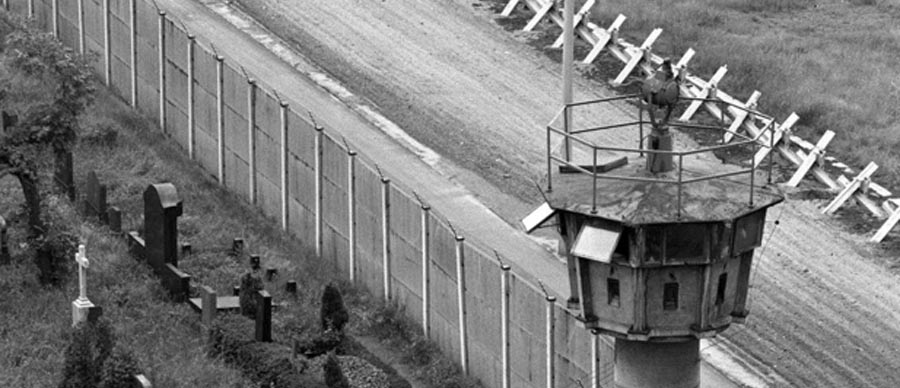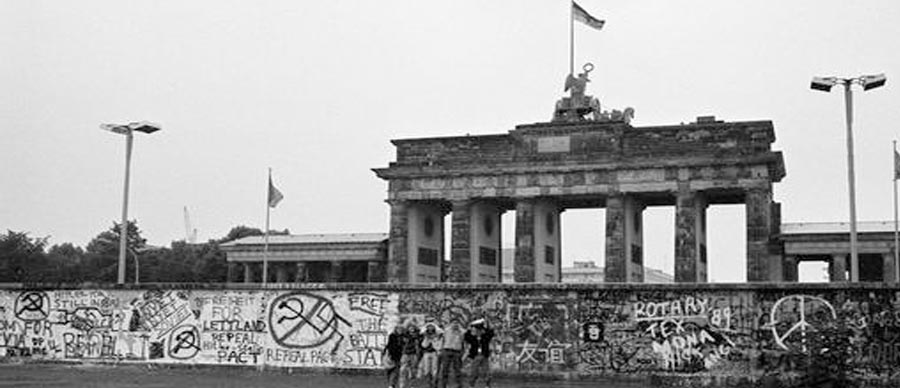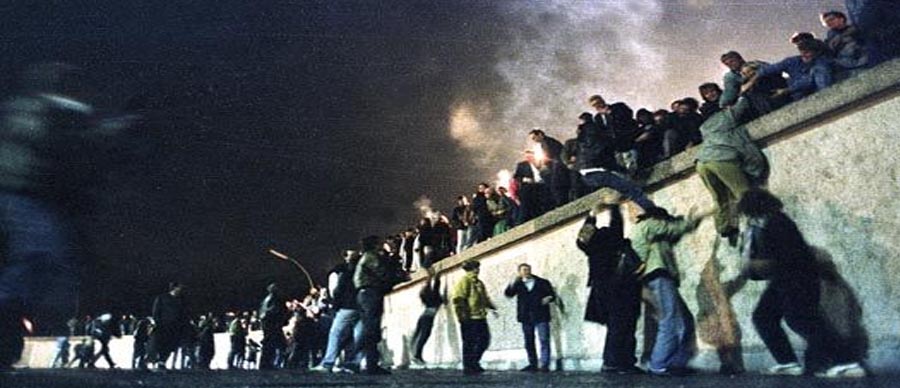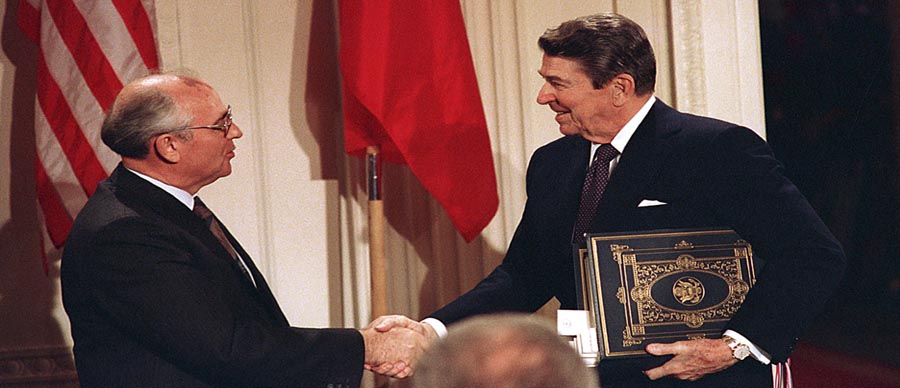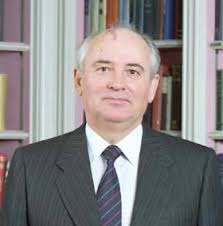
Mikhail Gorbachev was instrumental in the fall of the Berlin wall and the end of the cold war.
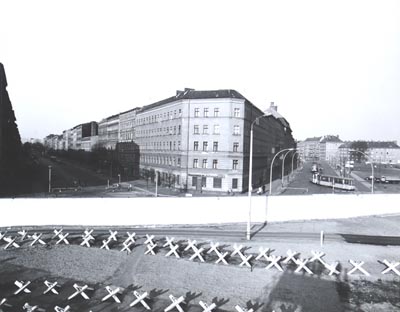
"The Anti Fascist Protection Barrier".
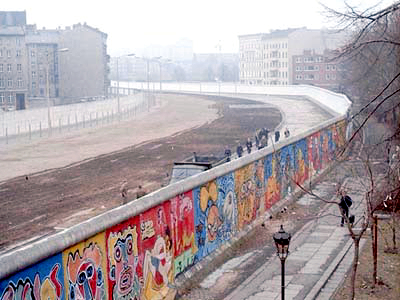
The Berlin wall was used as a canvas for many artists.
The Berlin Wall with a total length of 155 km around West Berlin was the border between East and West. Guard by border guards, barbed wire, mines and sentry guns made this border fortification almost insurmountable. The wall was the symbol of the East-West conflict. Praised by one side as "peace border" and "Anti-Fascist Protection Wall", condemned by the other side as "communist Shame". More than a quarter-century symbol of the division of Germany the Berlin Wall fell on November 9, 1989. This November 9, is firmly linked to the German unit, far more than the actual act of state a year later. He also reminds us of successful resistance and civil courage. The fall of the wall also marks the end of the Cold War.
In October 1989 Soviet President Mikhail Gorbachev carried out numerous reforms. Not only the ruling political positions of the Socialist Unity Party of Germany (SED), but also the media in the GDR were fundamentally changed. The mass exodus of East German citizens helped create new opposition movement and demonstrations put the East German government under pressure. Correspondents reported in 1989 open from demonstrations and rallies, were informed about the travel arrangements and the economic crisis in the GDR. In the fall of 1989, the Revolution captured the whole country. Not only in Leipzig and Berlin, the people demonstrate against the state and its interests. On the 1st September 1989, the World Day of Peace, people go to the small towns Neuruppin (north of Berlin) and Forest (near Cottbus) on the street. Especially young people were demanding the opening of borders.
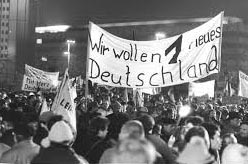 The Leipzig Monday demonstration on October 9th, 1989 is considered crucial for the peaceful revolution in East Germany. The people overcame their fear of the oppressors, a firing order would have been unimaginable. Free and peaceful attracted more than 70,000 demonstrators on the inner ring road until the Stasi headquarters. The government capitulated to the superior power of the citizens.
The Leipzig Monday demonstration on October 9th, 1989 is considered crucial for the peaceful revolution in East Germany. The people overcame their fear of the oppressors, a firing order would have been unimaginable. Free and peaceful attracted more than 70,000 demonstrators on the inner ring road until the Stasi headquarters. The government capitulated to the superior power of the citizens.
In November 1989, things started happening to beat in the East. Under pressure from the peaceful civic movement, the SED flinched. The dictatorship was in an open crisis, from which it shall never recover. The largest demonstration in the history of the GDR took place November 4, 1989 at the Berlin Alexanderplatz to the gathered peacefully over half a million people. In the SED leadership and the security apparatus, a tug of war over the question of whether one should prevent the demonstration began. Finally, the SED leadership decided that the demonstration should be approved. A key demand of the protesters was the freedom to travel.
The SED responded on 6 November 1989 with a design for a travel law, which was widely rejected. Under continuous pressure by mass exodus and demonstrations as well as by the action of the "SED reformers" met on 7 November 1989, the East German government back under Prime Minister Willi Stoph. Then came November 8, and the entire Politburo of the Central Committee (CC) of the SED back. In this situation, the Central Committee Plenum of the SED took place on 8 and 9 November 1989. At the same time a simple and far-reaching new travel law was drafted and read in the SED Central Committee. Hardly any of those present recognized the explosive nature of this design.
The Day: November 9, 1989 9am Clock: The Ministry of Interior of the GDR four officers come together to design a new departure control. The Politburo had given to the order. The first draft, which was two days before given the nod by the Soviet Union, sees only the permanent exit directly from the GDR (about an extra border crossing in the south) and not to third countries as Czechoslovakia before - but not a return to the GDR.
In a Ministerial Decision regulate the officers the right to departures. Any restrictions on applications for a permanent departure from the GDR should cease. Departures will need to be applied as before. On the initiative of Colonel Gerhard Lauter towards the round bumble into a momentous passage in the text: "private trips abroad can be applied without proof of eligibility (travel events and relationships). The licenses are issued at short notice "In plain English. Freedom of movement for all, organized will not be long and bureaucratic.
This Regulation shall apply until the conclusion of a travel law and on Friday, November 10, 4 clock, will be published. Already on the same day to all GDR citizens can apply for visa to the authorities. The paper goes directly to the Central Committee of the SED. Chronicle of the Wall: Gerhard Lauter, VP-Colonel, on the elaboration of the travel scheme in November 1989, 10 clock: The second consultation day of the SED Central Committee begins. The district base sets the 1st Secretaries Hans-Joachim Böhme Hall, Werner forest in Cottbus and John Chemnitzer in Neubrandenburg again. The long-standing women's representative of the SED Politburo Inge Lange enters from her post back. 12 clock: members of the Politburo confirmed in a smoking break of the Central Committee the report prepared by the officers travel regulation draft. It will be forwarded to the Council of Ministers. 15 clock: The Ministry of Interior and the State Security is filed to the implementing rules for the travel regulation. 16 clock: General Secretary Egon Krenz reads the SED Central Committee the travel regulation draft, which is now present him as a draft resolution of the Council of Ministers, including press release . 17.30 Clock: Krenz handed from the Council of Ministers-proposed resolution and a related press release Günter Schabowski. It is in these days spokesman for the SED Central Committee.
 By 6pm the live broadcast of the press conference with Günter Schabowski (1st Secretary of the SED district leadership Berlin), in which he provided information on the results of the Politburo meeting on the afternoon begins. at 06:57pm just before the end of the press conference clock asks the Italian journalist Riccardo Ehrman to see if the design of the Travel Act was not a mistake. Schabowski announced the astonished reporters that from now on West Travel for everyone are possible. Many East Germans see the message on television. The regulation was originally intended as a guide for the permanent departure in the Federal Republic of Germany (with no right of return). You should stop the ongoing Exit Requirements Power over Czechoslovakia. "That's why we decided to make today a provision that makes it any citizen of the GDR possible emigrate via border crossing points of the GDR. ... So private trips abroad can be applied without proof of eligibility, reasons for travel and family relationships. The licenses shall be issued in the short term ... This occurs as I know, uh, that is immediately, without delay. "
By 6pm the live broadcast of the press conference with Günter Schabowski (1st Secretary of the SED district leadership Berlin), in which he provided information on the results of the Politburo meeting on the afternoon begins. at 06:57pm just before the end of the press conference clock asks the Italian journalist Riccardo Ehrman to see if the design of the Travel Act was not a mistake. Schabowski announced the astonished reporters that from now on West Travel for everyone are possible. Many East Germans see the message on television. The regulation was originally intended as a guide for the permanent departure in the Federal Republic of Germany (with no right of return). You should stop the ongoing Exit Requirements Power over Czechoslovakia. "That's why we decided to make today a provision that makes it any citizen of the GDR possible emigrate via border crossing points of the GDR. ... So private trips abroad can be applied without proof of eligibility, reasons for travel and family relationships. The licenses shall be issued in the short term ... This occurs as I know, uh, that is immediately, without delay. "
19.04 Clock: Before the breaking news of the Western news agencies spread ADN the details of the announced by Schabowski previously, "immediately" applicable freedom of travel. The headline is selected neutral wisely: "GDR government spokesman to new travel regulations". Four points of the 20-line message that was originally only on Friday morning at 4:00 clock go to the wire. 19.05 Clock: These sets make history. AP spread as breaking news: "GDR opens border"; DPA to 19.41 clock: "The GDR border ... is open." The agency reports to the main news time to 20.15 clock to TOP-news on TV and radio. The "Tagesschau" reports "GDR opens border".
Even against 20.30 clock hit the first GDR citizens at the border crossing at Bornholmer Strasse in to see what's going on. The border crossing is still closed for GDR citizens without a valid visa. There are more and more people to the border crossing. 21.00 clock called on the amount the opening of the border. The situation comes to a head, the duty border guards have so far received no order to open the border and the crowd in front of the border crossing is calling: "for gate to open". It played out tumultuous scenes. Against 21.10 clock ended the Bundestag in Bonn on the occasion of the new provisions his meeting with the singing of the national anthem.
22.28 Clock: In the late edition of "Aktuelle Kamera" a final attempt is started on East German television, to slow down the development. "On requests of many citizens, we inform you again about the new travel regulations of the Council of Ministers," said the newscaster and expressly points out "that the travel must be applied". The passport and registration departments will be available tomorrow at the usual time open" and also permanent departures could take place only "after they have been applied for and approved."
23 against clock pushing thousands at the Bornholmer Strasse from back to front. At the turnpike, it is ever more threatening. No one knows exactly whether it is a rumor, a slip of the tongue or in fact a valid decision. The border guards are completely overwhelmed. Half an hour before midnight decide individual border commander, just to open the gates. The wall has fallen. At other crossings of the inner-German border, thousands of East Germans are enthusiastically welcomed in the West.
00:00 o`clock: All border crossings in Berlin are open. 00.20 Clock: 30 000 soldiers of the National People's Army (NVA) be placed in "increased combat readiness". Because in the night absent additional commands that provide commanders of border regiments the measures on their own responsibility a. Between 1 and 2 o`clock overcome thousands of West and East Berliners the Wall at Brandenburg Gate. You go on the Pariser Platz and through the gate. On the wall, the people dancing for joy. The concrete Wall is occupied by several thousand people. All over the place reverberates knocking the wall woodpeckers. Edit the wall on the west side with hammers and chisels. Of the transitions people flock to the Kurfürstendamm, which is transformed into the early hours in a party area. 2 Clock: The News from Radio DDR I Report, citing the Interior Ministry that the border can be passed "as a transitional measure" until the next morning, from 8.00 clock, upon presentation of the identity card. The political and military leadership of the German Democratic Republic comes into this night not public appearance.
November 10, 1989 - Day one after the Fall
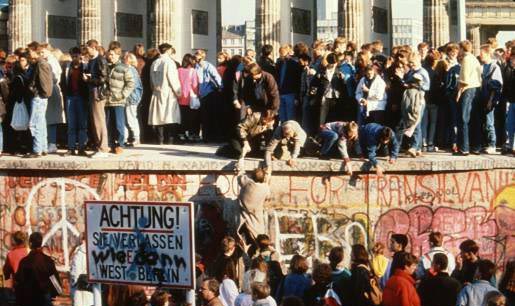 Thousands of people continue to flow through the border crossings. People clog the streets. All night and all day celebrations continue in Berlin. Images of people dancing on the wall, go around the world.
Thousands of people continue to flow through the border crossings. People clog the streets. All night and all day celebrations continue in Berlin. Images of people dancing on the wall, go around the world.
During the night 10 November assigns Berlin Governing Mayor Walter Momper the payment of money to welcoming GDR citizens in the amount of 100 DM by banks and savings banks. In long lines, people waiting in savings banks, banks and offices in the disbursement of welcome money.
In the afternoon declared the Soviet Foreign Minister Eduard Shevardnadze told the press that his country regarded the "events in the GDR as an innate issue its new leadership and their people and wish you every success ".
In the early evening Walter Momper, Hans-Dietrich Genscher, Willy Brandt and Helmut Kohl spoke in front of 40,000 people in front of the Schöneberg Town Hall. Momper called the Germans "now the happiest people in the world", Brandt welcomes the "compatriots over there and over here" and sees "Europe grow together" and Kohl says: "Long live a free German fatherland, long live a free united Europe."
The way to German unity A year later, on 3 October 1990, Germany is reunited after 45 years of separation. The cries of the GDR citizens for a united Germany became louder. The communist regime could not help but to bow to the pressure. With international assistance, and the policy of the Federal Republic of Germany should grow back together. After 1989 - The road to German unity is mapped out.
The reforms in the Soviet Union also had a major impact on the other socialist countries, but especially in Poland and Hungary.
With the recognition of the first free trade union Solidarność in Poland in early 1989 of the disintegration of the socialist system began. The Hungarian government opened at night to 11 September 1989, the border to Austria for GDR citizens. Tens of thousands of traveling in the next few days and weeks over Austria in the Federal Republic of. The GDR also drew in the Prague embassy conflict - where thousands of East Germans fled to force their departure - to Soviet pressure, a. In latched special trains several thousand East German refugees were accommodated on the territory of the GDR into the Federal Republic. The Iron Curtain was breached.
The peaceful revolution in 1989 with its mass protests swept across the East German regime and forced the fall of the Wall.
"I understand your question so: that there are people in West Germany who wish that we mobilize the construction workers of the capital of the GDR, to set up a wall on to, anyway, I do not know that such intention, because the construction workers in the capital mainly deal with housing and their labor is fully employed. Nobody intends to build a wall. " So the East Germans stated Walter Ulbricht on 15 June 1961 a press conference in Berlin. On August 13, work began on the construction of the Wall.
In October 1989 Soviet President Mikhail Gorbachev carried out numerous reforms. Not only the ruling political positions of the Socialist Unity Party of Germany (SED), but also the media in the GDR were fundamentally changed. The mass exodus of East German citizens helped create new opposition movement and demonstrations put the East German government under pressure. Correspondents reported in 1989 open from demonstrations and rallies, were informed about the travel arrangements and the economic crisis in the GDR. In the fall of 1989, the Revolution captured the whole country. Not only in Leipzig and Berlin, the people demonstrate against the state and its interests. On the 1st September 1989, the World Day of Peace, people go to the small towns Neuruppin (north of Berlin) and Forest (near Cottbus) on the street. Especially young people were demanding the opening of borders.
 The Leipzig Monday demonstration on October 9th, 1989 is considered crucial for the peaceful revolution in East Germany. The people overcame their fear of the oppressors, a firing order would have been unimaginable. Free and peaceful attracted more than 70,000 demonstrators on the inner ring road until the Stasi headquarters. The government capitulated to the superior power of the citizens.
The Leipzig Monday demonstration on October 9th, 1989 is considered crucial for the peaceful revolution in East Germany. The people overcame their fear of the oppressors, a firing order would have been unimaginable. Free and peaceful attracted more than 70,000 demonstrators on the inner ring road until the Stasi headquarters. The government capitulated to the superior power of the citizens.In November 1989, things started happening to beat in the East. Under pressure from the peaceful civic movement, the SED flinched. The dictatorship was in an open crisis, from which it shall never recover. The largest demonstration in the history of the GDR took place November 4, 1989 at the Berlin Alexanderplatz to the gathered peacefully over half a million people. In the SED leadership and the security apparatus, a tug of war over the question of whether one should prevent the demonstration began. Finally, the SED leadership decided that the demonstration should be approved. A key demand of the protesters was the freedom to travel.
The SED responded on 6 November 1989 with a design for a travel law, which was widely rejected. Under continuous pressure by mass exodus and demonstrations as well as by the action of the "SED reformers" met on 7 November 1989, the East German government back under Prime Minister Willi Stoph. Then came November 8, and the entire Politburo of the Central Committee (CC) of the SED back. In this situation, the Central Committee Plenum of the SED took place on 8 and 9 November 1989. At the same time a simple and far-reaching new travel law was drafted and read in the SED Central Committee. Hardly any of those present recognized the explosive nature of this design.
The Day: November 9, 1989 9am Clock: The Ministry of Interior of the GDR four officers come together to design a new departure control. The Politburo had given to the order. The first draft, which was two days before given the nod by the Soviet Union, sees only the permanent exit directly from the GDR (about an extra border crossing in the south) and not to third countries as Czechoslovakia before - but not a return to the GDR.
In a Ministerial Decision regulate the officers the right to departures. Any restrictions on applications for a permanent departure from the GDR should cease. Departures will need to be applied as before. On the initiative of Colonel Gerhard Lauter towards the round bumble into a momentous passage in the text: "private trips abroad can be applied without proof of eligibility (travel events and relationships). The licenses are issued at short notice "In plain English. Freedom of movement for all, organized will not be long and bureaucratic.
19.04 Clock: Before the breaking news of the Western news agencies spread ADN the details of the announced by Schabowski previously, "immediately" applicable freedom of travel. The headline is selected neutral wisely: "GDR government spokesman to new travel regulations". Four points of the 20-line message that was originally only on Friday morning at 4:00 clock go to the wire. 19.05 Clock: These sets make history. AP spread as breaking news: "GDR opens border"; DPA to 19.41 clock: "The GDR border ... is open." The agency reports to the main news time to 20.15 clock to TOP-news on TV and radio. The "Tagesschau" reports "GDR opens border".
Even against 20.30 clock hit the first GDR citizens at the border crossing at Bornholmer Strasse in to see what's going on. The border crossing is still closed for GDR citizens without a valid visa. There are more and more people to the border crossing. 21.00 clock called on the amount the opening of the border. The situation comes to a head, the duty border guards have so far received no order to open the border and the crowd in front of the border crossing is calling: "for gate to open". It played out tumultuous scenes. Against 21.10 clock ended the Bundestag in Bonn on the occasion of the new provisions his meeting with the singing of the national anthem.
22.28 Clock: In the late edition of "Aktuelle Kamera" a final attempt is started on East German television, to slow down the development. "On requests of many citizens, we inform you again about the new travel regulations of the Council of Ministers," said the newscaster and expressly points out "that the travel must be applied". The passport and registration departments will be available tomorrow at the usual time open" and also permanent departures could take place only "after they have been applied for and approved."
23 against clock pushing thousands at the Bornholmer Strasse from back to front. At the turnpike, it is ever more threatening. No one knows exactly whether it is a rumor, a slip of the tongue or in fact a valid decision. The border guards are completely overwhelmed. Half an hour before midnight decide individual border commander, just to open the gates. The wall has fallen. At other crossings of the inner-German border, thousands of East Germans are enthusiastically welcomed in the West.
00:00 o`clock: All border crossings in Berlin are open. 00.20 Clock: 30 000 soldiers of the National People's Army (NVA) be placed in "increased combat readiness". Because in the night absent additional commands that provide commanders of border regiments the measures on their own responsibility a. Between 1 and 2 o`clock overcome thousands of West and East Berliners the Wall at Brandenburg Gate. You go on the Pariser Platz and through the gate. On the wall, the people dancing for joy. The concrete Wall is occupied by several thousand people. All over the place reverberates knocking the wall woodpeckers. Edit the wall on the west side with hammers and chisels. Of the transitions people flock to the Kurfürstendamm, which is transformed into the early hours in a party area. 2 Clock: The News from Radio DDR I Report, citing the Interior Ministry that the border can be passed "as a transitional measure" until the next morning, from 8.00 clock, upon presentation of the identity card. The political and military leadership of the German Democratic Republic comes into this night not public appearance.
November 10, 1989 - Day one after the Fall
 Thousands of people continue to flow through the border crossings. People clog the streets. All night and all day celebrations continue in Berlin. Images of people dancing on the wall, go around the world.
Thousands of people continue to flow through the border crossings. People clog the streets. All night and all day celebrations continue in Berlin. Images of people dancing on the wall, go around the world. During the night 10 November assigns Berlin Governing Mayor Walter Momper the payment of money to welcoming GDR citizens in the amount of 100 DM by banks and savings banks. In long lines, people waiting in savings banks, banks and offices in the disbursement of welcome money.
In the afternoon declared the Soviet Foreign Minister Eduard Shevardnadze told the press that his country regarded the "events in the GDR as an innate issue its new leadership and their people and wish you every success ".
In the early evening Walter Momper, Hans-Dietrich Genscher, Willy Brandt and Helmut Kohl spoke in front of 40,000 people in front of the Schöneberg Town Hall. Momper called the Germans "now the happiest people in the world", Brandt welcomes the "compatriots over there and over here" and sees "Europe grow together" and Kohl says: "Long live a free German fatherland, long live a free united Europe."
The way to German unity A year later, on 3 October 1990, Germany is reunited after 45 years of separation. The cries of the GDR citizens for a united Germany became louder. The communist regime could not help but to bow to the pressure. With international assistance, and the policy of the Federal Republic of Germany should grow back together. After 1989 - The road to German unity is mapped out.
The way to the Fall of the Berlin Wall
With the election of Mikhail Gorbachev as General Secretary of the Central Committee of the Communist Party of the Soviet Union (CPSU) in 1985, gradually changed the policy in the largest socialist country in the world. Gorbachev's reforms, perestroika (reconstruction) and glasnost (openness) should renew the Stalinist system in the Soviet Union, but not eliminate socialism.The reforms in the Soviet Union also had a major impact on the other socialist countries, but especially in Poland and Hungary.
With the recognition of the first free trade union Solidarność in Poland in early 1989 of the disintegration of the socialist system began. The Hungarian government opened at night to 11 September 1989, the border to Austria for GDR citizens. Tens of thousands of traveling in the next few days and weeks over Austria in the Federal Republic of. The GDR also drew in the Prague embassy conflict - where thousands of East Germans fled to force their departure - to Soviet pressure, a. In latched special trains several thousand East German refugees were accommodated on the territory of the GDR into the Federal Republic. The Iron Curtain was breached.
The peaceful revolution in 1989 with its mass protests swept across the East German regime and forced the fall of the Wall.
Construction of the Berlin Wall - 13 August 1961
"Nobody intends to build a wall.""I understand your question so: that there are people in West Germany who wish that we mobilize the construction workers of the capital of the GDR, to set up a wall on to, anyway, I do not know that such intention, because the construction workers in the capital mainly deal with housing and their labor is fully employed. Nobody intends to build a wall. " So the East Germans stated Walter Ulbricht on 15 June 1961 a press conference in Berlin. On August 13, work began on the construction of the Wall.

